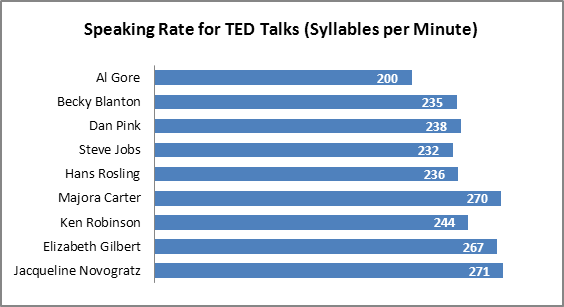In this article, we answer these questions and look at the factors which influence your speaking rate, a critical component of your delivery. How to calculate your speaking rateThe most common way to express one’s speaking rate is in words per minute (wpm). To calculate this, simply take the total number of words spoken and divide by the number of minutes it took you to speak them. Speaking Rate (wpm) = Total words / # of minutes Another way to measure speaking rate is in syllables per minute (spm): Speaking Rate (spm) = Total syllables / # of minutes Why syllables per minute? Not all words are equal. Consider these two sentences:
If you were to speak these two sentences at the same rate in words per minute, the first passage would seem considerably faster because you are saying more. Despite the sensibility of using syllables/minute, the words/minute measure is more commonly used, because it is generally easier to calculate. How to determine your speaking rateA really quick estimate of your speaking rate can be obtained by timing yourself while reading a selection of text with a known word count. Then, simply calculate using the method above. But, this is not really your speaking rate. It’s your reading rate. Even if you to read out loud, it’s not the same thing as a speaking rate. The best way to determine your speaking rate is to time yourself delivering a real speech with a real audience. (Video helps — you can count your words from it too.) What is the average speaking rate?The average speaking rate will vary across languages and situations. But, rather than dodging the question entirely, let’s come up an estimate given a fairly narrow speaking situation — TED talks — which we often study in Six Minutes speech critiques. I analyzed 9 TED talks which have been critiqued on Six Minutes. These talks ranged from just under 7 minutes in length to just under 20 minutes. Some speakers used visuals, some did not. Their topics were widely variable. [Click the links in the table below to view these speeches and read the critiques. Note that the Steve Jobs talk was not delivered at a TED conference, but is included on the TED website.]
One can also calculate the speaking rate for the 9 TED talks in syllables per minute, and these results are shown below, sorted in the same order as in the words/minute chart above.
What influences your overall speaking rate?There are many factors which influence your overall speaking rate:
All but the last two factors are completely within your control, and even those last two factors can be predicted somewhat. Is it better to speak faster or is is better to speak slower?It depends, but if you are anywhere close to the range of the speakers analyzed above (133 to 188 words/minute), you’re fine. Generally, slower is more intelligible than faster speech. Appropriate pauses allow your audience time to digest what you’ve said and begin to process it. However, instead of worrying too much about your numerical speaking rate, it probably would be better to focus on improving your clarity and lowering the complexity of your language.
Vary your speaking rate!No matter what your average speaking rate is over the entire speech, you should always vary it within a speech. Don’t deliver sentence after sentence at the same exact rate. Varying your speech rate adds life to your vocal delivery, and allows you to convey both meaning and emotional content. For example, you can speak a little faster to convey excitement, or a little slower to reflect sadness or confusion. Final ThoughtsI know very few people who speak considerably too slow, but many who speak too fast. Because of the common tendency to put too much content into our presentations, we tend to speak at a blazing speed to get through it all. So, in general, slow down! Like many delivery characteristics, the best way to be aware of whether you are doing it well is to solicit feedback. Ask trusted audience members whether your pace was too slow, too fast, or just right. | |||||||||||||||||||||
Similar Articles You May Like... |
| ||||||||||||||||||||
 Andrew Dlugan is the editor and founder of Six Minutes. He teaches courses, leads seminars, coaches speakers, and strives to avoid Suicide by PowerPoint. He is an award-winning public speaker and speech evaluator. Andrew is a father and husband who resides in British Columbia, Canada. Twitter: @6minutes | |||||||||||||||||||||
| © Six Minutes, 2012. | |||||||||||||||||||||
What is the Average Speaking Rate?
↧
↧
Trending Articles
More Pages to Explore .....
 A long-time reader asks:
A long-time reader asks:

























